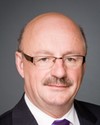Mr. Chair, honourable members of the Standing Committee on Official Languages, thank you.
The three of us are educators from Manitoba and we are pleased to appear before this committee today to talk about our experiences, our best practices and our recommendations to the federal government regarding the teaching of French in a predominantly English-speaking environment.
My name is Raymond Sokalski and I have taught social science in the French immersion program, at the high school level, for 23 years. I have spent most of that time teaching at Kelvin High School, close to downtown Winnipeg.
I am proud to be accompanied by my two distinguished colleagues: Chris Young, who is a history teacher in the international baccalaureate program, at Kelvin High School, and Laura Sims, who is a professor in the Faculty of Education, Université de Saint-Boniface. We have known each other for a long time as educators, and we are also former students of the immersion program.
Our presentations will first highlight how the immersion programs we pursued when we were young had an impact on our entire lives. We feel we must warn you that the description of our individual paths may seem a bit detailed because we wanted to show that the immersion programs we participated in and the community organizations that we joined have been supported by the federal government for many years and should still continue to receive that support.
Let me tell you about my personal experience. I come from a family of immigrants. My parents were manual workers and they enrolled me in the first short immersion program established in Manitoba in 1975. My classmates came from various backgrounds: single-parent families, working class, wealthy families, and so on. The six years I spent in this program and the enriching experiences I gained in my courses left their mark on me for the rest of my life. Our Canadian history textbooks came from Quebec; they were published by the Parti Quebecois government, which was new at the time. We had the opportunity to benefit from the conferences held at the Collège universitaire de Saint-Boniface, the Génies en herbe competition, the public speaking competition, exchange trips and special guests, all funded by the federal government.
During my first year of university, I was a page here in the House of Commons. That was in 1981, when the Constitution Act was passed. Three years later, I went with a group of volunteers to Sri Lanka as part of the Canada World Youth program. Thanks to those two programs, I became friends with a number of young francophones. All my short-term jobs, whether with the Canada Day committee, in Manitoba, at Service Canada or in Asia, with Alliance Française, were the result of the language skills I had acquired in the immersion program. As a result of those experiences, I completed my Bachelor of Education degree at Université de Saint-Boniface. I was one of the fewer and fewer anglophones who went to the francophone campus.
I have so far had the privilege of teaching some 7,000 students. My wife and I have two children. Since the day they were born, 14 years ago, I have been speaking to them in French 80% of the time. It is their paternal language. As a result, our family has become one of the new species of bilingual anglophone families who live in western Canada.
All of this started with the immersion program, which began 40 years ago in four schools in Manitoba and which now includes thousands of students across the province. Those students are changing the demographics and our vision of this country.


